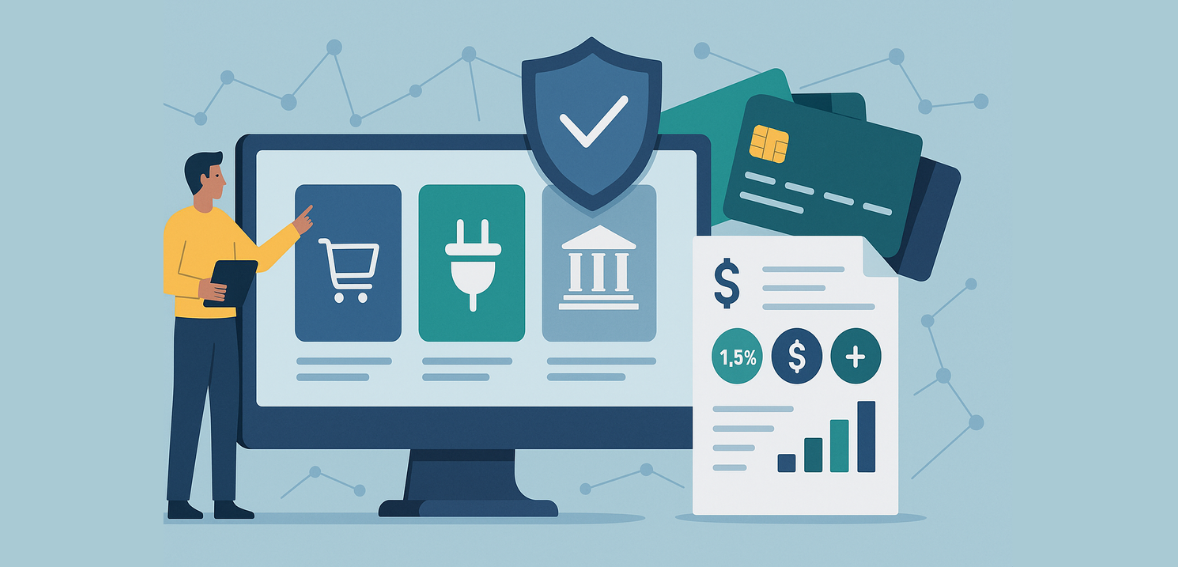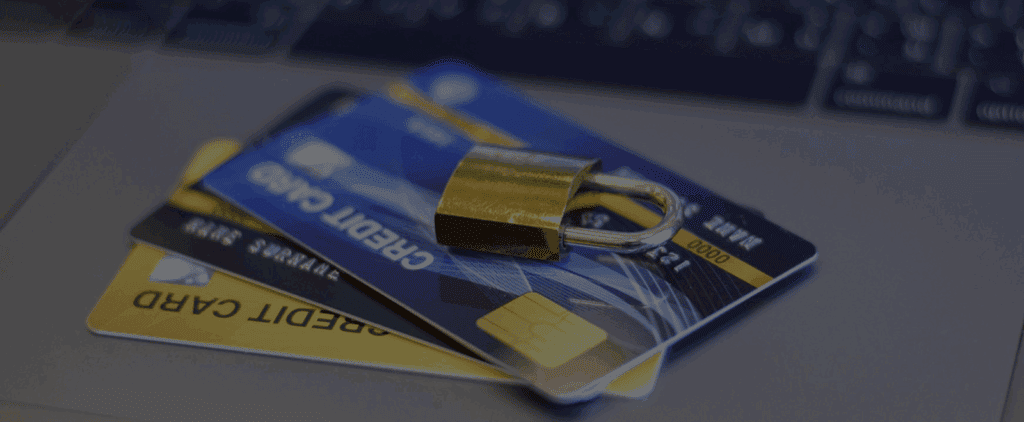
By Emily Robertson May 31, 2025
E-commerce operations depend on efficient and secure credit card payment processing systems to achieve marketplace success today. Payment operations in 2025 continue to develop through technologies while consumer payment rules and attitudes evolve. The complete guide on e-commerce credit card payment processing explores how business owners should understand and enhance their online payment processing through credit cards.
Understanding the Payment Processing Ecosystem

Key Players in the Payment Processing Chain
The credit card payment environment connects different entities through their interdependent relationships to complete transactions. Consumers activate the payment mechanism through their use of credit cards during online shopping. The merchants operate as businesses that accept credit card payments through their operations. Your shop requires payment gateways as software to create a bridge with the wider payment processing environment.
The payment processors handle all financial transactions between merchants and their banking institutions. The payment infrastructure belongs to Visa as well as Mastercard, with other major credit card networks. Consumers possess credit cards linked to issuing banks, which handle payments made by acquiring banks. An effective payment system needs an understanding of how networked parties interact to function properly.
The Transaction Flow Process
The process of a standard credit card payment during 2025 utilizes a complex sequence that operates at high speed. A payment gateway encrypts consumer credit card information, which gets transmitted to payment processors. Following encryption, the payment processor transmits transaction data to the proper card network. The transaction proceeds from the network to the issuing bank, where it receives an approval or rejection on account of available funds and the results of fraud detection software.
A payment gateway transmits the response to the payment processor after it receives the information from the transaction network. The e-commerce platform forwards the resulting transaction data to display it for the customer. It normally takes only seconds for approval, yet fund transfers to the merchant account require one to three operational days before completion.
Choosing the Right Payment Processing Solution

Payment Gateway Options in 2025
Numerous solutions now serve the payment gateway market, which underwent significant changes by 2025 to cover different business needs. A combination of e-commerce platforms and payment processing features makes up integrated payment solutions. Companies in need of flexible payment options can utilize third-party gateways which supply end-to-end APIs and worldwide solutions. A wide range of competitive merchant services with direct integration features are provided by various banking institutions.
Specialized payment solutions exist for businesses that operate in high-risk fields or specialized business sectors. Embedded finance platforms directly connect financial services to other non-financial items. Merchants should decide their gateway based on the transaction costs combined with payment methods, universal application, integrative capabilities, and security protocols which match their business operations.
Fee Structures and Pricing Models
Payment processing fees of 2025 contain multiple components which affect the business’ financial outcome. The transaction costs vary from 1.5% to 3.5% yet include a static fee for each transaction based on card type and risk rating. Some payment processors providers impose monthly fees to their customers while ignoring the number of transactions done during the month.
Account setup and integration procedures require payment of setup fees to providers. Payment processors charge fees to companies whose customers file chargeback disputes against their transactions. Payment transactions involving foreign sales require adjustment through conversions of currencies. Several financial companies impose periodic charges for account maintenance to their users.
Pricing models for payment processing now follow three basic methods. Processors utilize interchange-plus pricing to add a profit margin to the payment rates card networks specify. Through flat-rate pricing all types of transactions get charged using a single uniform percentage. In subscription-based payment models business operators receive monthly fees supported by small transaction fees. The pricing system groups transactions under multiple price levels based on rate values. Many processors now deliver pricing models which integrate fundamental parts from multiple different structures. Most e-commerce businesses with a small to medium size can gain the best pricing clarity through interchange-plus or flat-rate payment fee plans.
Implementation and Integration
Technical Implementation Steps
Payment processing of an online store happens through various specific steps. Software entities can begin payment processing by establishing either a direct merchant account or utilizing payment service provider options. Integrating your payment gateway establishes a connection between your processor and online store. The payment method configuration determines the list of accepted payment options including cards and alternative methods for your store.
Sandbox testing procedures verify that the entire payment system functions correctly during evaluation before moving to the live deployment stage. The security deployment process verifies how well the system meets PCI DSS standards and other essential safeguarding controls. Executing the last steps involves three activities: moving from testing to production phase then implementing transaction monitoring software. The modern e-commerce sector provides simple integrated procedures that enable non-technical merchants to work with top payment processing networks.
Mobile Payment Integration
The future success of businesses depends heavily on mobile payment optimization because mobile commerce is expected to control 70% of e-commerce transactions in 2025. Digital wallets allow customers to complete payments through their widely used mobile payment apps. TellMePlus implements responsive checkout pages combined with a mobile-friendly payment system form.
As a security measure and user-friendly solution biometric authentication uses fingerprints together with facial recognition. Single-click payments create secure mechanisms that allow shoppers to save information for future automated purchases. Users benefit from QR code payment services because the scanning-based payment method keeps rising in adoption rate. Mobile integration practices focus on three main priorities which involve reducing form fields and providing automatic form completion abilities while also delivering fast page loading times across all devices to stop customers from leaving.
Security and Compliance

PCI DSS Compliance in 2025
The Payment Card Industry Data Security Standard (PCI DSS) executes ongoing improvements that lead to version 5.0 which stands as the present standard for 2025. The PCI DSS compliance requirement includes multiple security elements such as network protection for cardholder information along with encryption protocols and programs for vulnerability assessment and strict access controls and recurring security tests and formal information security guidelines.
Payment processing services now offer tokenization together with hosted payment pages which allows merchants to reduce their PCI compliance tasks while maintaining secure payment standards extensively across the entire transaction system.
Fraud Prevention Technologies
Current fraud prevention technologies have progressed by 2025 to provide superior protective measures. Artificial intelligence risk scoring motors actively track hundreds of operational factors in real-time to calculate payment systems risk levels. The detection of trust patterns in transactions happens through solutions which identify the devices being used. Authenticating users involves behavioral biometric analysis that studies typing rhythm together with mouse trail patterns and additional discreet behavioral elements. Advanced authentication systems present users with secure transactions combined with an uninterrupted purchasing experience.
Changes in transaction security codes happen periodically through a schedule to reduce the opportunities for fraudsters. Network intelligence platforms use multi-merchant detection patterns to provide fraud warning alerts. The optimal security against advanced fraud techniques results from applying multiple authentication systems which maintain a smooth user experience.
Optimizing the Customer Experience
Streamlining the Checkout Process
E-commerce companies continue to struggle with cart abandonment because complicated checkout processes serve as a main cause according to customers’ reports. The year 2025 will introduce two effective solutions which allow users to make purchases without account registration through guest checkout features. The express checkout feature provides a one-click buying service that serves loyal customers throughout their transactions.
The checkout process shows clear indications to buyers about how their transaction is advancing. Telephone field reduction combines essential data collection with automatic data formatting to decrease data entry mistakes. A real-time check of shipping information occurs through address validation systems. Error handling which employs excellent strategies provides customers with both short and immediate error feedback. Quick future purchases become possible through secure payment data storage for regular customers.
By implementing these optimizations correctly cart abandonment rates can reduce fifteen to thirty percent at once which represents significant advancement over normal conversion rates.
Alternative Payment Methods
Successful e-commerce companies in 2025 use different payment methods beyond traditional credit cards to serve their customer base. Non-charging payment options are gaining more popularity because they allow customers to make purchases with delayed or installment payments. Modern consumers can make purchases using cryptocurrency at most mainstream online stores. Customers can perform direct account-to-account payments between various banking systems. Digital wallets enable platform users to gain access to easy purchasing experience.
Payment systems that run on closed loops function only on specified platform networks. International trade relies on local payment methods because they preserve essential elements of local customer preferences. Online stores maximize conversion rates best by offering customers between four and six secure payment methods that do not burden checkout simplicity or operations support.
Data Analysis and Optimization

Key Performance Metrics
To optimize payment processing, focus on several key metrics to determine areas to improve. Conversion rate quantifies the percentage of visitors making purchases. Authorization rate records the proportion of transactions that are approved by issuing banks. Decline rate tracks transactions that are rejected during processing. Chargeback rate estimates the proportion of completed transactions that are later disputed by customers.
Average transaction value gives insight into buying behavior. Payment method distribution indicates customer choice between alternatives. Cart abandonment rate helps to detect potential checkout problems. Processing costs percentage of revenue aid in assessing its efficiency in payment processing. Constant monitoring of such factors allows merchants to detect areas of system improvement and revenue increase.
A/B Testing Payment Flows
Ongoing improvement by systematic testing is now critical for maximizing payment systems. Merchants now routinely test various presentations of payment modes to find best arrangements. Checkout page layout experiments with varying arrangements of pages disclose preferred arrangements for various customer segments. Multi-step versus single-page checkout process comparisons identifies the most effective method for certain business models.
Security feature presentation evaluations optimize protection versus convenience. Testing various wording on fees and policies can increase transparency and credibility. Conducting controlled experiments where the success measure is clearly stated allows merchants to iteratively better the payment process over time with increasing conversion by data-driven improvement.
Global E-commerce Considerations
Cross-Border Payment Processing
The following factors require special attention when companies plan international sales in 2025. Customers who use multi-currency options can pay with their national money that improves both trust levels and transaction conversion rates. The system of dynamic currency conversion functions in real-time to display exchange rates. Specific payment methods available for local customers support the regional customs and preferences. Transparent visualization of tax and duties stops buyers from experiencing surprise costs at checkout time.
The security rules within international fraud screening adapt to different market risk levels. The established terms and conditions under settlement options specify payment schedule and merchant account funding transfer procedures. Merchant expansion into international markets becomes feasible through integrated payment solutions developed by international processors who work with cross-border transactions.
Regional Payment Preferences
Payment patterns are extremely varied across the world’s regions, requiring tailored approaches. North American consumers favor credit cards, online wallets, and buy-now-pay-later. European consumers favor bank transfers, online wallets, and credit cards. The Asia-Pacific region favors mobile wallets, QR code payments, and bank transfers. Latin American markets emphasize installment payments, cash vouchers, and local card networks.
Middle Eastern and African consumers commonly employ mobile money services, cash on delivery, and prepaid payment devices. An understanding of and response to such regional trends then becomes the passport to successful global expansion, as markets continue to develop unique payment ecosystems that reflect local financial infrastructure and consumer patterns.
Future Trends in E-commerce Credit Card Payment Processing
Emerging Technologies
Payment processing technologies create multiple radical changes which generate future business opportunities while facing implementation challenges. Biometric authentication expands its security scope by integrating voice pattern along with behavioral identifier identification method technologies. Payment processes operate behind the scenes automatically because there are no traditional checkout requirements necessary during transactions. Customers who join approved payment platforms receive immediate money transfers through visible payment processing systems.
Consumers can complete their purchasing tasks by using content platforms as transaction guidance systems. Multimedia environments using ambient intelligence technology let payment systems identify physical locations to modify their operational methods according to present scenarios and areas. Future encryption threats receive security through measures based on quantum-resistant technology combined with emerging encryption protocols. Future-oriented organizations can enhance their payment system flexibility because they gain visibility into upcoming payment methods.
Regulatory Changes On the Horizon
The regulatory structures are developing rapidly to present companies with new opportunities and regulatory hurdles. Global adoption of open banking requirements now surpasses European territories leading to fresh payment initiation possibilities. The payment data storage requirements of data localization rules mandate national compliant operations within country borders. Consumer protection laws received upgrades which brought forth new requirements about transaction disclosures and dispute settlement procedures.
The global identity verification system unites different countries through their frameworks. Strategic customer authentication systems now operate across regulatory regions that extend past the European boundaries. Traditional payment systems could experience changes because of central bank digital currencies (CBDCs) which governments produce as national digital currency. Companies that follow regulatory changes enjoy improved compliance standards as well as new business opportunities resulting from updated financial standards and regulations.
Conclusion
With the exponential growth of e-commerce, efficient credit card payment processing is crucial for the success of online businesses. Online businesses can create seamless payment experiences that maximize conversion rates while minimizing risks and costs by understanding the ecosystem, identifying suitable partners, implementing effective security measures, optimizing customer experiences, and forecasting future trends.
In 2025, the most successful e-commerce companies view payment processing as a strategic necessity rather than just a utility function—investing in practices and technologies tailored to their specific business models and customer requirements. Merchants could transform payment processing into a competitive growth driver and customer loyalty enhancer in a more digital economy by treating it as a strategic imperative rather than an afterthought.